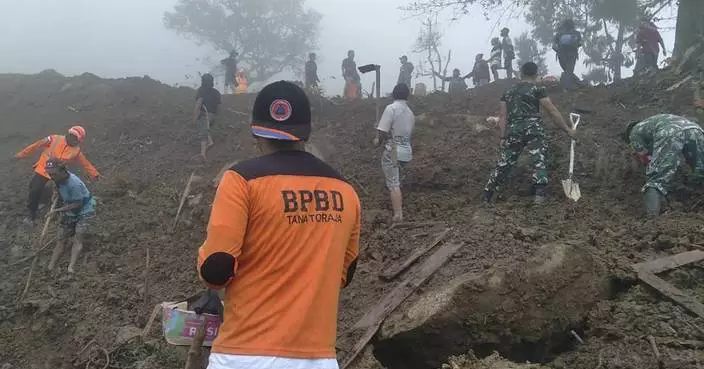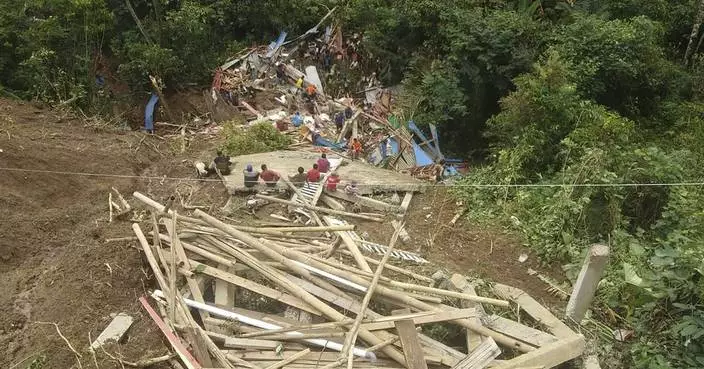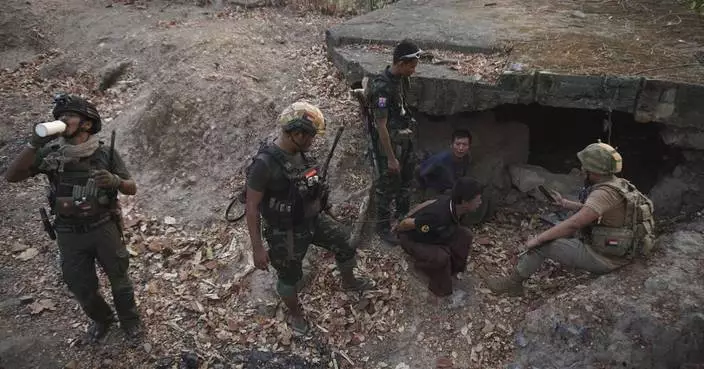The hill on which the young woman's shelter is being built is so unstable that the earth crumbles under your feet. The threat of landslides is so dire that her neighbors have evacuated. Though living here could spell doom as the monsoon rains fall, she will live here anyway.
For Mustawkima, a Rohingya woman who fled Myanmar for the refugee camps of neighboring Bangladesh, there is no other option.
Click to Gallery
The hill on which the young woman's shelter is being built is so unstable that the earth crumbles under your feet. The threat of landslides is so dire that her neighbors have evacuated. Though living here could spell doom as the monsoon rains fall, she will live here anyway.
Hers is a dilemma repeated over and over for many of the 900,000 Rohingya refugees living in ramshackle huts across this unsteady landscape: With the long-dreaded monsoon season now upon them, they have run out of places to run.
The bamboo shelter on the crumbling hillside will be Mustawkima's third attempt at finding a home in the camps. She has had to do everything on her own; Her husband was killed when the military stormed their village in August 2017.
Frightened, she sold off some of her donated rations of rice, lentils and oil so she could hire men to build her a sturdier shelter in the same spot. The bamboo and sandbags were donated by aid agencies. She fears there isn't enough material, but she has no money to buy extra bamboo.
"Within 24 hours of the first rains falling, we were seeing small landslides and we were seeing flooding everywhere," says Daphnee Cook, a spokeswoman for Save the Children. "I've been here for seven months and I was appalled at how quickly things started to fall apart."
Aid workers have cleaned out thousands of latrines. Children are receiving identity bracelets in case they are separated from parents in the flooding. Families have received extra materials to fortify their shelters. Trenches have been dug to try and redirect floodwaters.
More than 200,000 people are living in areas considered at risk of landslides and flooding, according to the ISCG. Around 34,000 refugees have been relocated to other areas, with some moving into sturdier shelters further away from the hills.
Yet at least her family is safe, for now. Abu Bakker's family lives at the base of a hill where a landslide destroyed eight shelters. A few weeks ago, Bakker's 60-year-old mother was trying to scoop a bit of soil out of their shelter when a deluge of mud crashed through their tarp wall, knocking her to the ground and burying her up to her thighs.

In this June 26, 2018, photo, Rohingya refugees walk in the rain though Jamtoli refugee camp in Bangladesh. The monsoon season has arrived in Bangladesh, bringing fresh dangers to the 900,000 Rohingya refugees who live in ramshackle huts on unstable hills. (AP Photo/Wong Maye-E)
Hers is a dilemma repeated over and over for many of the 900,000 Rohingya refugees living in ramshackle huts across this unsteady landscape: With the long-dreaded monsoon season now upon them, they have run out of places to run.
For months, officials raced to relocate the most at-risk families to safer areas that had been bulldozed flat, but there simply isn't enough available land. Most refugees believe it is too dangerous to return to Myanmar, where the military launched a brutal campaign of violence against the minority Rohingya Muslims last year. And so, as the rains begin to flood parts of the camps, many Rohingya find themselves trapped — by geography, by poverty and by fear.
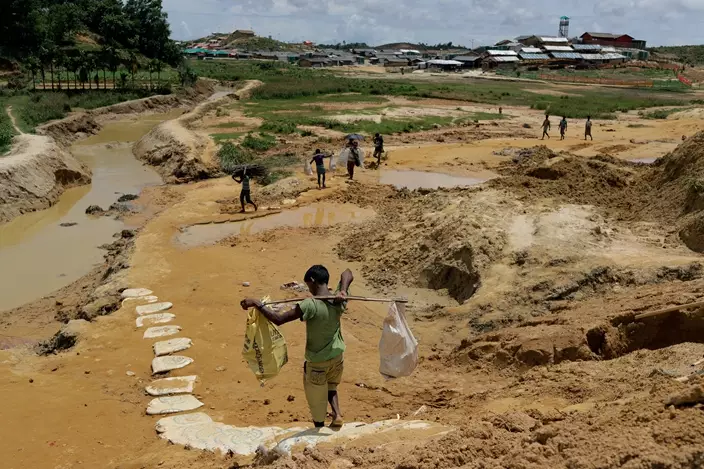
In this June 28, 2018, photo, Rohingya refugees carry construction material to an extended area of Kutupalong refugee camp in Bangladesh where some refugees living in areas considered at risk of landslides and flooding were relocated to. The monsoon season has arrived in Bangladesh, bringing fresh dangers to the 900,000 Rohingya refugees who live in ramshackle huts on unstable hills. (AP Photo/Wong Maye-E)
The bamboo shelter on the crumbling hillside will be Mustawkima's third attempt at finding a home in the camps. She has had to do everything on her own; Her husband was killed when the military stormed their village in August 2017.
Mustawkima, who like some Rohingya uses only one name, abandoned her first shelter when the soil washed away. With five children under the age of 8, she wanted her new home to be close to relatives living at the base of the hill, so she erected a flimsy tarp halfway up. But when the rains began in June, the water quickly poured in, transforming her dirt floor into a muddy mess.
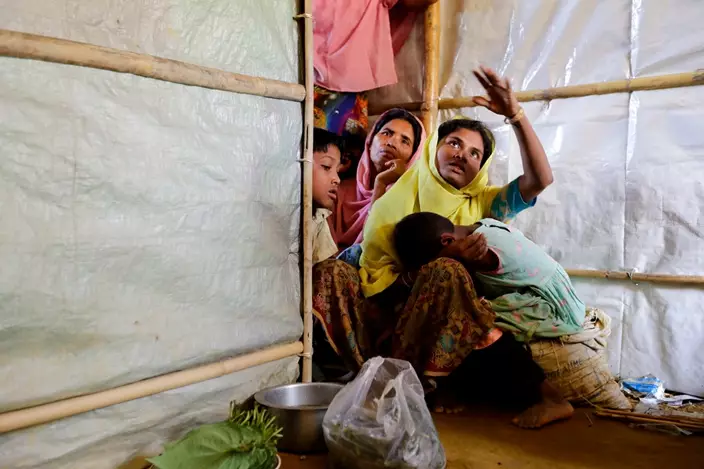
In this June 28, 2018, photo, Mustawkima, sits in her relative's shelter as she talks about abandoning her previous shelters destroyed by heavy rains in Balukhali refugee camp, Bangladesh. The monsoon season has arrived in Bangladesh, bringing fresh dangers to the 900,000 Rohingya refugees who live in ramshackle huts on unstable hills. (AP Photo/Wong Maye-E)
Frightened, she sold off some of her donated rations of rice, lentils and oil so she could hire men to build her a sturdier shelter in the same spot. The bamboo and sandbags were donated by aid agencies. She fears there isn't enough material, but she has no money to buy extra bamboo.
Families living in five shelters on the hill recently evacuated, she says. She can only hope that her relatives will protect her and her children when the worst of the rains arrive.
The most intense rains are expected over the next few months, though heavy downpours began pummeling the camps in June. There have already been more than 160 landslides, 30 people injured and one toddler killed, according to the Inter Sector Coordination Group, or ISCG, which oversees the aid agencies in the camps.
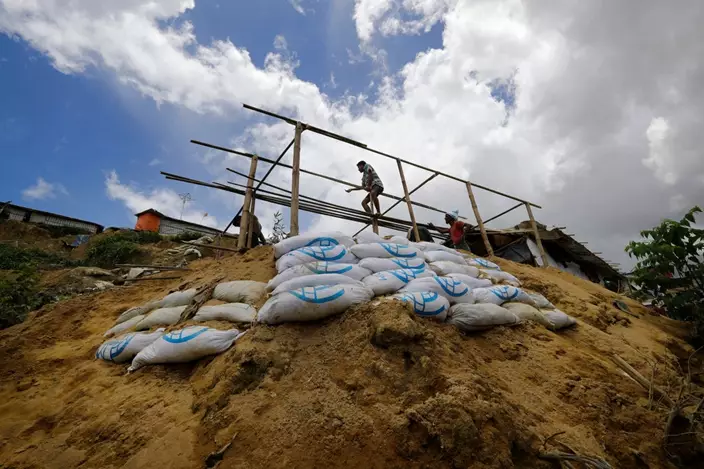
In this June 28, 2018, photo, a man is silhouetted as he builds a new shelter for Mustawkima, whose former shelter was destroyed by heavy rains in Balukhali refugee camp, in Bangladesh. Mustawkima sold off her donated rations of rice, lentils and oil so she could hire men to build her a sturdier shelter. The bamboo and sandbags were donated by aid agencies. The monsoon season has arrived in Bangladesh, bringing fresh dangers to the 900,000 Rohingya refugees who live in ramshackle huts on unstable hills. (AP Photo/Wong Maye-E)
"Within 24 hours of the first rains falling, we were seeing small landslides and we were seeing flooding everywhere," says Daphnee Cook, a spokeswoman for Save the Children. "I've been here for seven months and I was appalled at how quickly things started to fall apart."
The ferocity of the rains and the swiftness with which they can wreak havoc is stunning. On a recent day, it took just minutes for a downpour to transform the face of another hill into a waterfall, with torrents of muddy water cascading down dirt steps.
Beyond the landslides and flooding, there are worries about waterborne diseases like cholera. Some of the latrines are piled high with fly-riddled excrement, which seeps out the sides during downpours. Water pumps are generally just a few meters away — worse, some are located downhill.
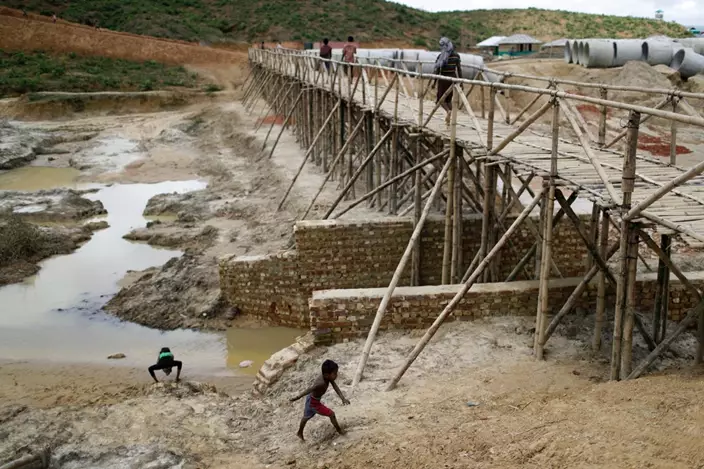
In this June 28, 2018, photo, Rohingya refugees cross a newly built bridge in the extended area of Kutupalong refugee camp in Bangladesh where some refugees living in areas considered at risk of landslides and flooding were relocated to. The monsoon season has arrived in Bangladesh, bringing fresh dangers to the 900,000 Rohingya refugees who live in ramshackle huts on unstable hills. (AP Photo/Wong Maye-E)
Aid workers have cleaned out thousands of latrines. Children are receiving identity bracelets in case they are separated from parents in the flooding. Families have received extra materials to fortify their shelters. Trenches have been dug to try and redirect floodwaters.
Ultimately, though, the topography of the camps is the biggest problem. The trees that once covered the hills have been cut down to make room for shelters, and the roots dug up for firewood. That process has dramatically loosened the soil, which the rains turn into heavy mud that slips down the hillsides, burying anything in its path.
The jagged scar on Mohamed Alom's head is a grim reminder of the dangers of those landslides. The 27-year-old was asleep in his shelter last month when a torrent of mud crashed through the plastic wall next to him. A tree root slammed into his head, slicing open his skin. His agonized screams awakened his wife and two young children, who rushed him to a doctor.
Now, he and his family are among 13 people living in a one-room schoolhouse. Alom is hoping officials will help him build a new shelter, but he has no idea how long that will take.
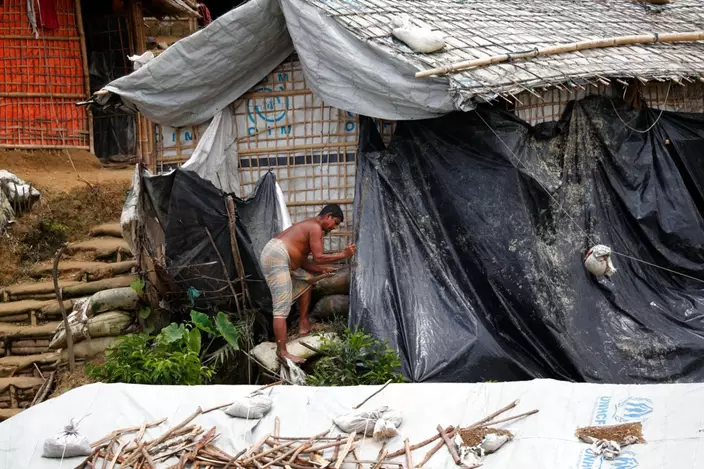
In this June 27, 2018, photo, a man covers his shelter with waterproof tarp as he prepares for the monsoon season in Chakmarkul refugee camp, Bangladesh. The monsoon season has arrived in Bangladesh, bringing fresh dangers to the 900,000 Rohingya refugees who live in ramshackle huts on unstable hills. (AP Photo/Wong Maye-E)
More than 200,000 people are living in areas considered at risk of landslides and flooding, according to the ISCG. Around 34,000 refugees have been relocated to other areas, with some moving into sturdier shelters further away from the hills.
Hotiza Begum, 25, recently moved into one of the new shelters with her husband and five children after mud crashed through the roof of her old one. She likes her relatively spacious new home. But it is hard to find firewood, she says, because they now live far from the mountains. And the markets can only be reached by tuk tuk, which costs about $1 — more than they can afford.
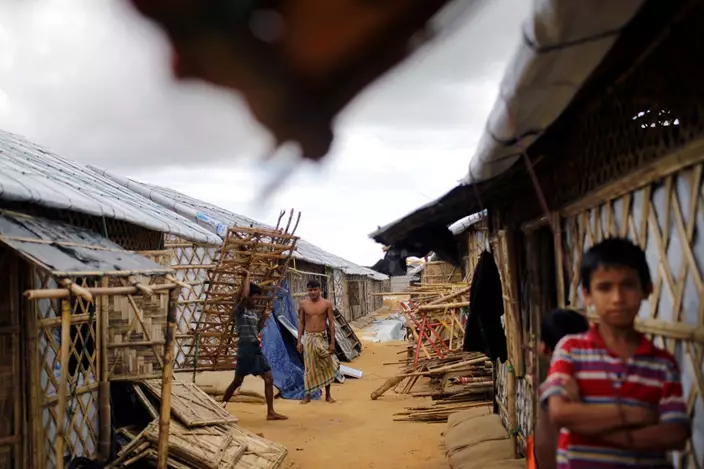
In this June 28, 2018, photo, Rohingya refugees carry construction material through huts built in an extended area of Kutupalong refugee camp in Bangladesh where some refugees living in areas considered at risk of landslides and flooding were relocated to. The monsoon season has arrived in Bangladesh, bringing fresh dangers to the 900,000 Rohingya refugees who live in ramshackle huts on unstable hills. (AP Photo/Wong Maye-E)
Yet at least her family is safe, for now. Abu Bakker's family lives at the base of a hill where a landslide destroyed eight shelters. A few weeks ago, Bakker's 60-year-old mother was trying to scoop a bit of soil out of their shelter when a deluge of mud crashed through their tarp wall, knocking her to the ground and burying her up to her thighs.
Bakker dug his terrified mother out and knew he had to get his family away. An aid group promised him supplies to rebuild, but they still haven't arrived. And even if they do, he asks, where will he rebuild?

In this June 25, 2018, file photo, a Rohingya child refugee carries an umbrella as he walks through Kutupalong refugee camp in Bangladesh. The monsoon season has arrived in Bangladesh, bringing fresh dangers to the 900,000 Rohingya refugees who live in ramshackle huts on unstable hills. (AP Photo/Wong Maye-E, File)
He is scared whenever it rains, which is often. He prays every day for Allah to protect them.
Still, for many Rohingya refugees who have made it through mass killings, rapes and other abuse in a military crackdown, the fear of the monsoon is relative.
"In Myanmar, it's scary because there's no guarantee for our lives," says Alom, as the rain begins to fall on the roof. "Here, even if there's a landslide, at least we don't have to worry about the military."
SANTA FE, N.M. (AP) — A movie weapons armorer received the maximum sentence of 18 months in jail for involuntary manslaughter in the fatal shooting of a cinematographer by Alec Baldwin on a Western movie set, as authorities now turn their focus on prosecution of Baldwin himself.
A New Mexico judge on Monday found that Hannah Gutierrez-Reed's recklessness amounted to a serious violent offense, while noting few indications of genuine remorse from the defendant since her conviction in March. Prosecutors blame Gutierrez-Reed for unwittingly bringing live ammunition onto the set of “Rust,” where it was expressly prohibited, and for failing to follow basic gun-safety protocols .
Attention now turns to Baldwin's upcoming trial on a charge of involuntary manslaughter in the October 2021 death of Halyna Hutchins at a movie ranch on the outskirts of Santa Fe.
Baldwin, the lead actor and co-producer of the film, was pointing a gun at Hutchins during a rehearsal when the gun went off, killing her and wounding director Joel Souza. Baldwin has pleaded not guilty and says he pulled back the hammer — but not the trigger — and the gun fired.
Here are some things to know as the “Rust” case against Baldwin nears:
Prosecutors on Monday described a “cascade of safety violations” on the movie set that only start with Gutierrez-Reed.
At sentencing, Gutierrez-Reed said she had tried to do her best on the set despite not having “proper time, resources and staffing," and that she was not the monster that people have made her out to be.
But Judge Mary Marlowe Sommer said the maximum sentence was appropriate given Gutierrez-Reed’s recklessness. She said remorse was lacking and rejected a request by defense attorneys for leniency and a conditional discharge that would have avoided further jail time.
The judge ticked through a checklist of safety failures by Gutierrez-Reed, pointedly answering her own questions.
“Did she have enough time to load the weapon safely? Plenty,” the judge said. “Did you load the weapon? Yes — with dummies and a live round. Did she check what she was loading? No.”
Hutchins, who was 42 when she died, grew up on a remote Soviet military base and worked on documentary films in Eastern Europe before studying film in Los Angeles and embarking on a promising movie-making career.
At the sentencing hearing, friends and family members described Hutchins as courageous, tenacious and compassionate.
Courtroom testimonials also included calls for justice and a punishment that would instill greater accountability for safety on film sets.
Ukrainian relatives of Hutchins are seeking damages in her death from Baldwin in connection with the shooting. Attorney Gloria Allred is representing Hutchins' parents and sister and says that the family supports the criminal prosecution of Baldwin.
“No one has ever come to me to apologize,” Hutchins' mother Olga Solovey said in a tearful video testimonial shown at the sentencing of Gutierrez-Reed.
The filming of “Rust” moved to Montana after Hutchins' death under an agreement with her husband, Matthew Hutchins, that made him an executive producer.
Prosecutors dismissed an earlier involuntary manslaughter charge against Baldwin after being told the gun he was holding might have been modified before the shooting and malfunctioned.
A new analysis of the gun opened the way for prosecutors to reboot the case. A grand jury indicted Baldwin on the same charge in January. The indictment alleges Baldwin caused Hutchins' death — either by negligence or “total disregard or indifference” for safety.
If he’s convicted, the charge carries a potential prison sentence of up to 18 months.
Defense attorneys for Baldwin are urging the judge to dismiss the grand jury indictment, accusing prosecutors of “unfairly stacking the deck” in grand jury proceedings that diverted attention away from exculpatory evidence and witnesses.
Special prosecutors deny those accusations and accuse Baldwin of “shameless” attempts to escape culpability, highlighting contradictions in Baldwin's statements to law enforcement, workplace safety regulators and the public in a televised interview.
An FBI expert testified at Gutierrez-Reed's trial that the revolver used by Baldwin was fully functional with safety features when it arrived at an FBI laboratory. The expert said he had to strike the fully cocked gun with a mallet and break it in order for it to fire without depressing the trigger.
Defense attorney Jason Bowles said Gutierrez-Reed will appeal the judge's judgment and sentence against her.
Bowles said at sentencing that “there were multiple system failures by multiple people. Some of those people have come before the court. ... Some have yet to come before the court. At least one individual is going to be tried in July.”
Gutierrez-Reed was acquitted of an evidence tampering charge at trial, but still confronts another felony charge in separate proceedings on allegations she brought a gun into a bar in downtown Santa Fe.
At her sentencing, Gutierrez-Reed teared up as Hutchins’ agent, Craig Mizrahi, spoke about the cinematographer’s creativity and described her as a rising star in Hollywood.
But special prosecutor Kari Morrissey says she reviewed nearly 200 phone calls that Gutierrez-Reed had made from jail over the last month. She said she was hoping there would be a moment when the defendant would take responsibility for Hutchins' death or express genuine remorse but "that moment has never come.”
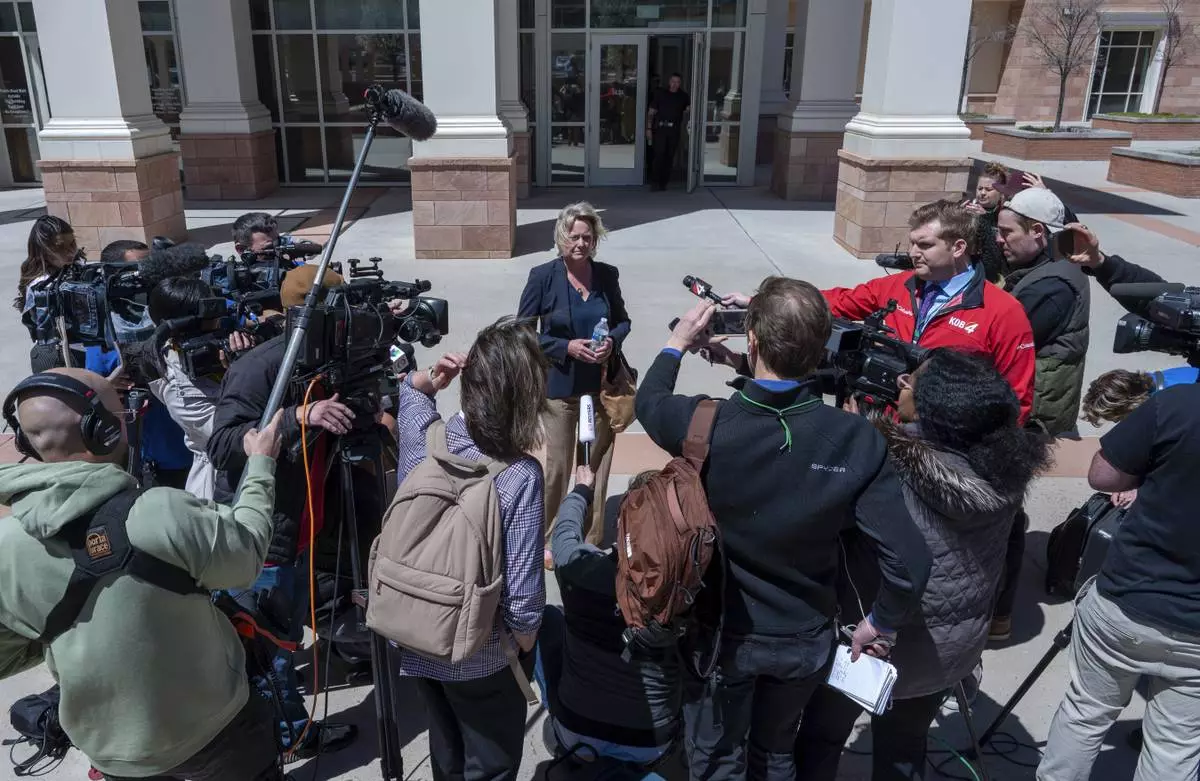
Special prosecutor Kari Morrissey speaks to the media outside the Santa Fe County Courthouse after Hannah Gutierrez-Reed was sentenced to 18 months in prison, following a hearing in Santa Fe, New Mexico, on Monday April 15, 2024. Gutierrez-Reed, the armorer on the set of the Western film "Rust," was convicted in March of involuntary manslaughter in the death of cinematographer Halyna Hutchins, who was fatally shot by Alec Baldwin during a rehearsal in 2021. (Eddie Moore/Albuquerque Journal via AP)

Olga Solovey, speaks by video from Ukraine, during the sentencing hearing for Hannah Gutierrez-Reed in state district court in Santa Fe, New Mexico, on Monday April 15, 2024. Gutierrez Reed, the armorer on the set of the Western film "Rust," was convicted of involuntary manslaughter in the death of Solovey's daughter, cinematographer Halyna Hutchins, who was fatally shot by Alec Baldwin during a rehearsal in 2021. (Eddie Moore/Albuquerque Journal via AP, Pool)
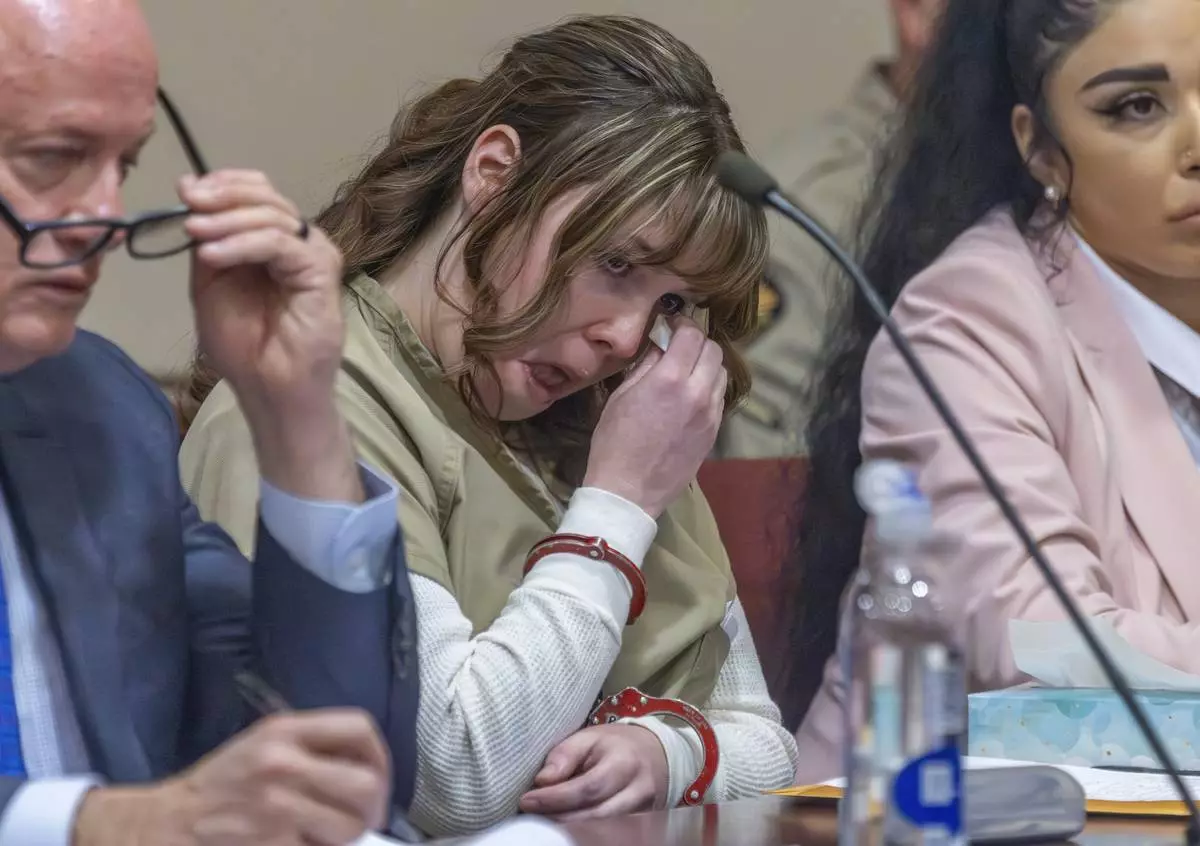
Hannah Gutierrez-Reed wipes her tears at her sentencing hearing in state district court in Santa Fe, New Mexico, on Monday, April 15, 2024. Gutierrez-Reed, the armorer on the set of the Western film "Rust," was sentenced to 18 months in prison for involuntary manslaughter in the death of cinematographer Halyna Hutchins, who was fatally shot by Alec Baldwin in 2021. (Luis Sánchez Saturno/Santa Fe New Mexican via AP, Pool)
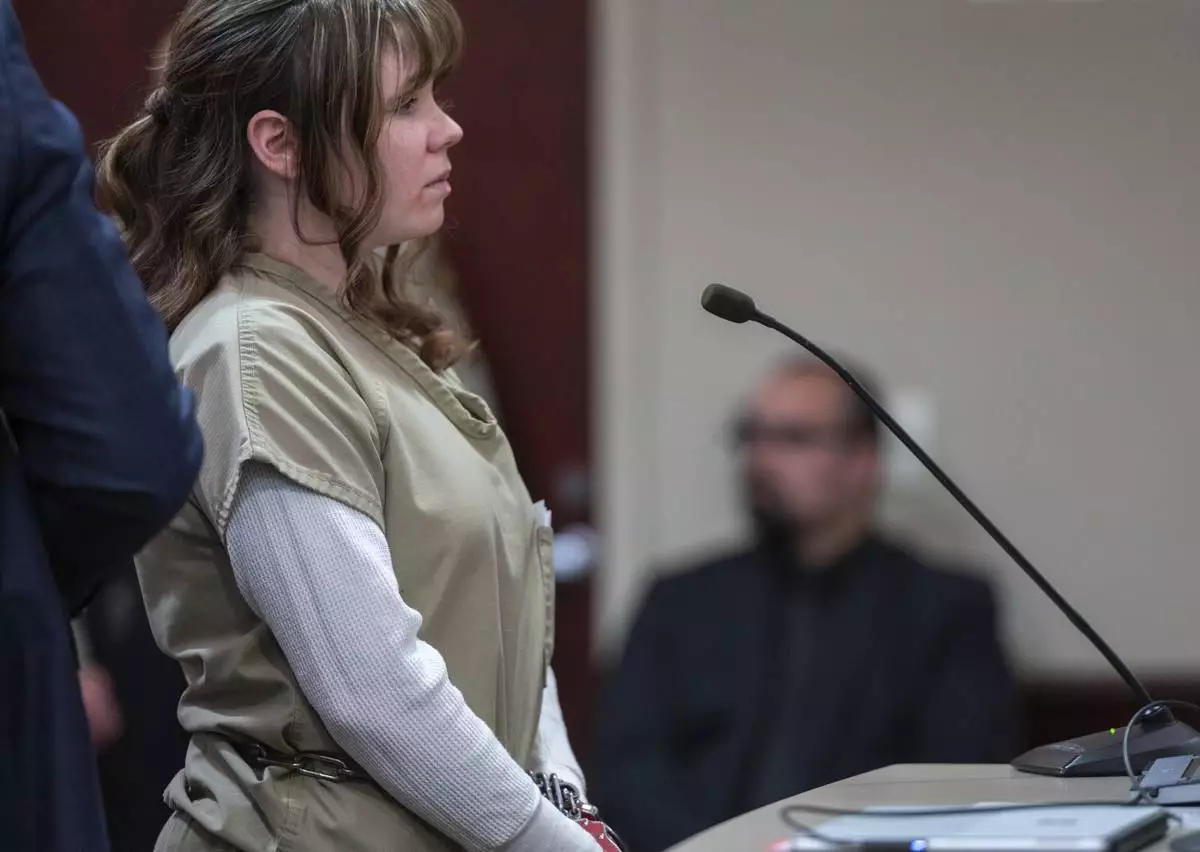
Hannah Gutierrez-Reed makes a statement to the court during her sentencing hearing in Santa Fe, New Mexico, on Monday April 15, 2024. Gutierrez-Reed, the armorer on the set of the Western film "Rust," was sentenced to 18 months in prison. She was convicted in March of involuntary manslaughter in the death of cinematographer Halyna Hutchins, who was fatally shot by Alec Baldwin in 2021. (Eddie Moore/Albuquerque Journal via AP, Pool)















